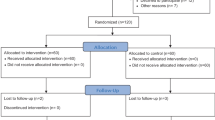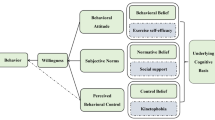Abstract
Some investigators have concluded that health beliefs do not influence the maintenance of coronary heart disease (CHD) exercise adherence. However, the beliefs tested have not been specific to CHD nor exercise. In addition, much of the research has been atheoretical. We conducted a retrospective study to explore the possibile utility of the Health Belief Model (HBM) for explaining attendance at a supervised CHD exercise program, based in a community center. Two dimensions of the model, general health motivation and perceived severity of CHD, were associated with attendance in the theoretically predicted direction, while a third dimension, perceived benefits of exercise, was associated in a direction opposite that predicted by the model. The model as a whole accounted for 29% (adjustedR 2) of the variance. This study provides some initial evidence that health beliefs are associated with CHD exercise adherence.
Similar content being viewed by others
References
Healthy People 2000. Boston: Jones and Bartlett Publishers, 1992.
Patrick CH, Palesch YY, Feinleib M, Brody JA. Sex differences in declining cohort death rates from heart disease.Am J Public Health 1982; 72:161–166.
Paffenbarger R, Hyde R, Wing A, Steinmetz C. A natural history of athleticism and cardiovascular health.J Am Med Assoc 1984; 52:491–495.
Powell KE, Thompson PD, Caspersen CJ, Kendrick JS. Physical activity and the incidence of coronary heart disease.Annu Rev Public Health 1987; 8:253–287.
Carmody TP, Senner JW, Malinow MR, Matarazzo JD. Physical exercise rehabilitation: Long-term dropout rate in cardiac patients.J Behav Med 1980; 3:163–168.
Oldridge N. Compliance and exercise in primary and secondary prevention of coronary heart disease: A review.Prev Med 1982; 11:56–70.
Epstein LH, Wing RR, Thompson JK, Griffin W. Attendance and fitness in aerobic exercise: The effects of contract and lottery procedures.Behav Modif 1980; 4:465–479.
Shephard RJ, Corey P, Kavanagh T. Exercise compliance and the prevention of a recurrence of myocardial infarction.Med Sci Sponts Exerc 1981; 13:1–5.
Dishman, R.K. Compliance/adherence in health-related exercise.Health Psychol 1982; 1:237–267.
Dishman RK. Biologic influences on exercise adherence.Res Q Exerc Sport 1981; 52:143–159.
Massie JF, Shephard, RJ. Physiological and psychological effects of training: A comparison of individual and gymnasium programs, with a characterization of the exercise drop-out.Med Sci Sports 1971; 3:110–117.
Dishman RK, Ickes W, Morgan WP. Self-motivation and adherence to habitual physical activity.J Appl Soc Psychol 1980; 10:115–131.
Mirotznik J, Speedling E, Stein R, Bronz C. Cardiovascular fitness program: Factors associated with participation and adherence.Public Health Rep 1985; 100:13–18.
Oldridge NB. Compliance with exercise programs. In ML Pollock, and DH Schmidt (Eds.)Heart Disease and Rehabilitation. Boston: Houghton Mifflin, 1979, pp. 619–629.
Baekeland R, Lundwall L. Dropping out of treatment: A critical review.Psychol Bull 1975; 82: 738–783.
Dishman RK, Gettman LR. Psychobiologic influences on exercise adherence.J Sport Psychol 1980; 2: 295–310.
Heinzelmann F, Bagley RW. Response to physical activity programs and their effects on health behaviors.Public Health Rep 1970; 85:905–911.
Wilhelmsen L, Sanne H, Elmfeldt D, Grimby G, Tibblin G, Wedel H, A controlled trial of physical training after myocardial infarction: Effects of risk factors, nonfatal reinfarction, and death.Prev Med 1975; 4:491–508.
Andrew GO, Parker JO. Factors related to dropout of post myocardial infarction patients from exercise programs.Med Sci Sports Exerc 1979; 11:376–378.
Pollock ML, Gettman LR, Milesis CA, Bah M, Durstine L, Johnson M. Effects of frequency and duration of training on attrition and incidence of injury.Med Sci Sports 1977; 9:31–36.
Sonstroem RJ. Psychological models. In RK Dishman (Ed.)Exercise Adherrence. Illinois: Human Kinetics Books, 1988, pp 125–153.
Sonstroem RJ, Kampper KP. Prediction of athletic participation in middle school males.Res Q Exerc Sport 1980; 51:685–694.
Fishbein M, Ajzen I.Belief, Attitude, Interntion, and Behavior: An Introduction to Theory and Research. Reading, MA: Addison-Wesley, 1975.
Kirscht, JP. The health belief model and predictions of health actions. In DS Gochman (Ed.)Health Behavior. New York: Plenum Press, 1988, pp 27–41.
Dishman RK. Health psychology and exercise adherence.Quest 1982; 33:166–180.
Dishman RK. (Ed.).Exercise Adherence. Illinois: Human Kinetics Books, 1988, pp 1–9.
Mullen PD, Hersey JC, Iverson DC. Health behavior models compared.Soc Sci Med 1987; 24: 973–981.
Valois P, Desharnais R, Godin G. A comparison of the Fishbein and Ajzen and the Triandis attitudinal models for the prediction of exercise intention and behavior.J Behav Med 1988; 11: 459–472.
Kendzierski D, Lamastro VD. Reconsidering the role of attitudes in exercise behavior: A decision theoretic approach.J. Appl Soc Psychol 1988; 18:737–759.
Duda JL, Smart AE, Tappe MK. Predictors of adherence in the rehabilitation of athletic injuries: An application of personal investment theory.J Sport Exerc Psychol 1989; 11:367–381.
Dzewaltowski DA. Toward a model of exercise motivation.J Sport Exerc Psychol. 1989; 11:251–269.
Oldridge NB. Compliance with exercise in cardiac rehabilitation. In RK Dishman (Ed.)Exercise Adherrence. Illinois: Human Kinetics Books, 1988, pp 283–305.
Becker MH. The health belief model and personal health behavior.Health Educ Monogr 1974; 2: 324–508.
Janz HK, Becker MH. The health belief model: A decade later.Health Educ Q 1984; 11:1–47.
Maiman LA, Becker MH. The health belief model: Origins and correlates in psychological theory.Health Educ Monogr 1974; 2:336–353.
Becker MH. The health belief model and sick role behavior.Health Educ Monogr 1974; 2:409–419.
Becker MH, Drachman RH, Kirscht JP. Motivations as predictors of health behavior.Health Sev Res 1972; 87:852–862.
Becker MH, Drachman RH, Kirscht JP. A new approach to explaining sick-role behavior in low income populations.Am J Public Health 1974; 64:205–216.
Becker MH, Maiman LA, Kirscht JP, Haefiner DP, Drachman RH. The health belief model and prediction of dietary compliance: A field experiment.J Health Soc Behav 1977; 18:348–366.
Lindsay-Reid E, Osborn RW. Readiness for exercise adoption.Soc Sci Med 1980; 14A:139–146.
Morgan WP, Shephard RJ, Finucane R, Schimmelfing L, Jazmaji V. Health beliefs and exercise habits in an employee fitness programme.Can J App Sport Sci 1984; 9:87–93.
Tirrel BE, Hart LK. The relationship of health beliefs and knowledge to exercise compliance in patients after coronary bypass.Heart Lung 1980; 9:487–493.
Robertson D, Keller C. Relationships among health beliefs, self-efficacy, and exercise adherence in patients with coronary artery disease.Heart and Lung 1992; 21:56–63.
Oldridge NB, Streiner DL. The health belief model: predicting compliance and dropout in cardiac rehabilitation.Med Sci Sports Exerc 1988; 22:678–683.
King AC, Blair SN, Bild DE, Dishman RK, Dubbert PM, Marcus BH, Oldridge NB, Paffenbarger RS, Powell KE, Yeager KK. Determinants of physical activity and interventions in adults.Med Sci Sport Exerc 1992; 24:221–236.
Perkins KA, Epstein LH. Methodology in exercise adherence. In RK Dishman (Ed.)Exercise Adherence. Illinois: Human Kinetics Books, 1988, pp 399–416.
Shephard RJ. Exercise adherence in corporate settings: Personal traits and program barriers. In RK Dishman (Ed.)Exercise Adherrence, Illinois: Human Kinetics Books, 1988, pp 305–319.
Steinhardt MA, Carrier KM. Early and continued participation in a work-site health and fitness program.Res Q Exerc Sport 1989; 60:117–129.
Noland M. The effects of self-monitoring and reinforcement on exercise adherence.Res Q Exerc Sport 1989; 60:216–224.
Becker MH, Kabak MM, Rosenstock IM, Ruth MV. Some influences on public participation in a genetic screening program.J Comm Health 1975; 1:3–14.
Maiman LA, Becker MH, Kirscht JP, Haefner DP, Drachman RH. Scales for measuring health belief model dimensions: A test of predictive value, internal consistency and relationships among beliefs.Health Educ Monogr 5:215–230, 1977.
Babbie E.The Practice of Social Research. Belmont, CA: Wadsworth Publishing Co., 1986.
Sudman S, Bradburn MH.Asking Questions: A Practical Guide to Questionnaire Design. San Francisco: Jossey-Bass Publishers, 1987.
Eisen M, Zellman GL, McAlister AL. A health belief model-social learning theory approach to adolescents' fertility control: Findings from a controlled field trial.Health Educ Q 1992; 19: 249–262.
Jetter AM, Cummings KM, Brock BM, Phelps MC, Naessens J. The structure of health belief indices.Health Sci Res 1981; 16:81–98.
Wankel LM.Program interventions to enhance exercise adherrence. Paper presented at the VI World Congress of Sport Psychology, Copenhagen, Denmark, 1985.
Cohen J, Cohen P.Applied Multiple Regression/Correlation Analysis for the Behavioral Sciences. Hillsdale, NJ: Lawrence Erlbaum Associates, Publishers, 1983.
Cohen J.Statistical Power Analysis for the Behavioral Sciences. Hillsdale, NJ: Lawrence Erlbaum Associates, 1988.
Brock B.Factors Influencing Intentions and Behavior Toward Swine Flu Vaccine. Doctoral dissertation, University of Michigan, 1984.
Calnan MW, Moss S. The health belief model and compliance with education given at a class in breast self-examination.J Health Soc Behav 1984; 25:198–210.
McKinlay JB. Some approaches and problems in the study of the use of services-An overview.J Health Soc Behav 1972; 14:115–152.
Rosenstock IM. Prevention of illness and maintenance of health. In J Kosa et al (Eds.)Poverty and Health. Mass: Harvard University Press, 1969, pp 168–190.
Author information
Authors and Affiliations
Rights and permissions
About this article
Cite this article
Mirotznik, J., Feldman, L. & Stein, R. The health belief model and adherence with a community center-based, supervised coronary heart disease exercise program. J Community Health 20, 233–247 (1995). https://doi.org/10.1007/BF02260407
Issue Date:
DOI: https://doi.org/10.1007/BF02260407




